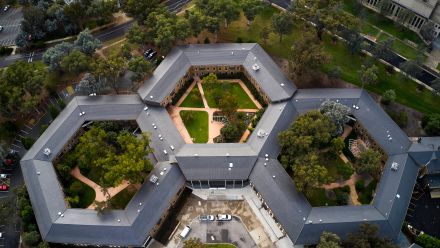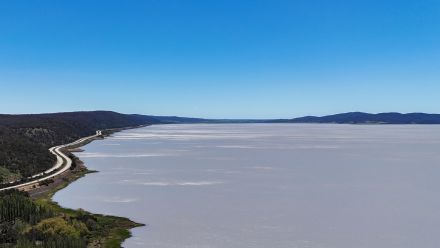One of the largest types of carbon offset projects the Australian government is using to meet climate change targets and reduce carbon in the atmosphere is failing to do so, new research has shown.
The projects aim to regenerate native forests across large parts of Australia, but analysis shows most of the selected areas have never had forests, are unsuitable for forest regeneration and are not producing the increase in tree canopy cover that projects are being credited for.
Australian human-induced forest regeneration (HIR) projects are the largest pure carbon removal nature-based offset type in the world. They are supposed to be regenerating permanent even-aged native forests across millions of hectares of Australia’s dry outback, primarily by reducing grazing pressure from livestock and feral animals.
The projects cover 42 million hectares—an area significantly larger than Japan—and, to date, they have received more than 45 million Australian carbon credit units (ACCUs) (30 per cent of all ACCUs issued under the Australian carbon offset scheme), worth approximately $1 billion.
New research conducted by 10 leading researchers from The Australian National University (ANU), University of New South Wales (UNSW) and Haizea Analytics has found extreme levels of non-compliance with key regulatory requirements in 116 of these human-induced regeneration (HIR) projects, and that the projects have had little impact on tree cover and carbon sequestration.
The study applied tests for regulatory compliance in line with the legal requirements of the HIR method and the Clean Energy Regulator’s own guidelines, which involved dividing the credited areas of the projects into 100-hectare cells (35,362 cells) and analysing each cell. To assess whether projects resulted in additional increases in tree cover that would not have otherwise occurred, each cell was matched to a 100-hectare cell from the surrounding landscape, outside of the project areas, and statistical analysis was conducted to determine whether the project cells outperformed the matched cell.
The researchers conducted their analysis using the same remotely sensed imagery that was applied in a recent verification report commissioned by the Clean Energy Regulator.
Headline results include:
- Contrary to the legal method requirements, 95% of credited area cells are located on land that has not previously been comprehensively cleared, meaning the projects are trying to regenerate native forests on uncleared land which may have never contained forests.
- Contrary to the legal method requirements, 29 per cent of credited area cells had forest cover when the projects started, meaning they are trying to regenerate native forests on land that already had forest cover when the projects began. In 41 projects (35 per cent of the sample), more than 50 per cent of their cells did not satisfy the requirements to exclude forested areas.
- 45 per cent of credited area cells did not satisfy the remote imagery components of the Clean Energy Regulator’s first regeneration gateway check, which is supposed to provide assurance regeneration is occurring. This is particularly alarming because the regeneration gateway checks are lenient, allowing projects to pass the test based on pre-existing tree cover, even if tree cover has not increased. The analysis also occurred at the end of a rare run of three consecutive wet years (2020-23), when canopy cover will naturally be higher than usual.
- The analysis of relative performance between credited cells and matched external cells found the projects had an overall statistically significant but small positive impact on canopy cover that was not commensurate with how the projects have been credited.
- There is a very large disparity between the levels of credited sequestration and the observed levels of canopy cover change. Based on the levels of credited sequestration, the average minimum expected level of canopy cover across the projects in 2023 was 30 per cent. Yet average canopy cover in the credited area of the projects in 2023 was only 13 per cent. The gap between observed and credited canopy cover change appears to be too large to be explained by known issues with satellite-based canopy cover estimates.
The findings confirm and expand upon the results from a study published earlier this year in the Nature-stable journal, Communications Earth & Environment.
Dr Megan Evans from UNSW Canberra, stated that the findings highlight a significant missed opportunity to restore previously cleared biodiversity-rich woodlands and forests via legitimate carbon offset projects:
“A decade ago, there was great hope that carbon markets could cost-effectively restore biodiversity where it has been destroyed by clearing, largely in Australia’s agricultural zones. Now, we’re seeing that 95% of the places being paid to restore forests occur in largely remote inland areas that have never actually been cleared of forests. Our new findings point to such huge failures that it’s almost beyond belief. Unfortunately, we expect that government and industry will simply respond by saying we’ve got it wrong, we’ve used the wrong data, and continue to deny there is a problem.”
Professor Don Butler from ANU said the results point to major administrative failings in Australia’s carbon credit scheme:
“Consistent with our previous research, our new findings suggest the observed changes in tree cover are predominantly attributable to factors other than the project activities, most likely rainfall. The Clean Energy Regulator’s administration of Australia’s carbon credit scheme has let us all down terribly. They have allowed these projects to proliferate in areas where the method was never intended to apply. They’ve used hundreds of millions of dollars of public money to build a house of cards that is enabling climate inaction and will render the Safeguard Mechanism ineffective. The failure of this scheme will only become more obvious as time goes on.”
Dr Kristen Hunter (UNSW) and Dr Maldwyn Evans (ANU) led the statistical analysis:
“While approximately half of the sampled projects had a small statistically significant positive effect relative to comparison areas, the other half had either a statistically significant negative effect, or no effect. Whether a project had a positive statistical effect essentially amounts to flipping a coin”, Dr Evans emphasised.
Dr Hunter added: “Crucially, a positive statistical effect doesn’t necessarily equate to good project performance. We found the amount of carbon sequestration credited to the projects did not correspond to actual changes in tree cover.”
The findings are published in The Rangeland Journal. The paper can be accessed at: https://doi.org/10.1071/RJ24024


